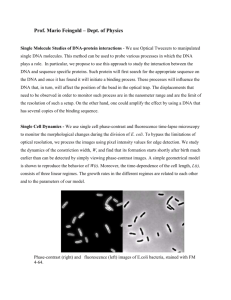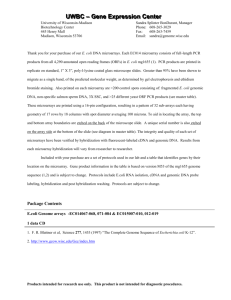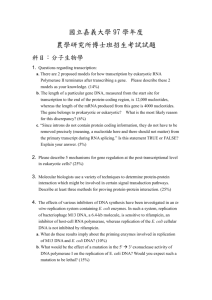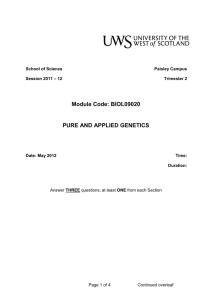Mutation
advertisement
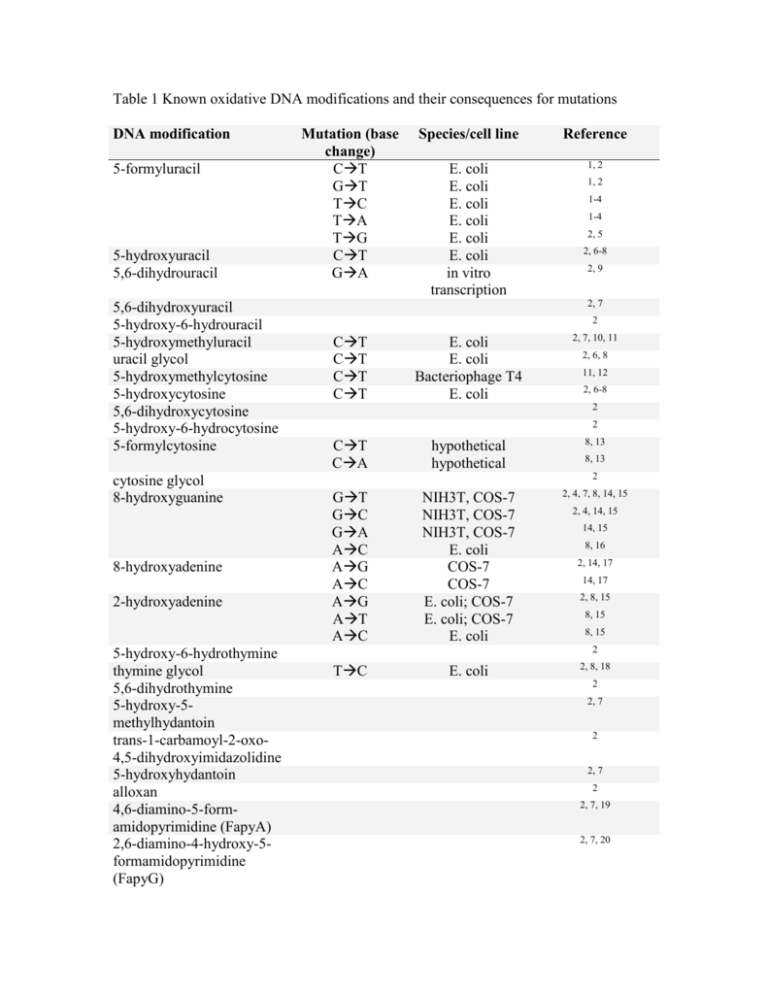
Table 1 Known oxidative DNA modifications and their consequences for mutations DNA modification 5-formyluracil 5-hydroxyuracil 5,6-dihydrouracil 5,6-dihydroxyuracil 5-hydroxy-6-hydrouracil 5-hydroxymethyluracil uracil glycol 5-hydroxymethylcytosine 5-hydroxycytosine 5,6-dihydroxycytosine 5-hydroxy-6-hydrocytosine 5-formylcytosine cytosine glycol 8-hydroxyguanine 8-hydroxyadenine 2-hydroxyadenine 5-hydroxy-6-hydrothymine thymine glycol 5,6-dihydrothymine 5-hydroxy-5methylhydantoin trans-1-carbamoyl-2-oxo4,5-dihydroxyimidazolidine 5-hydroxyhydantoin alloxan 4,6-diamino-5-formamidopyrimidine (FapyA) 2,6-diamino-4-hydroxy-5formamidopyrimidine (FapyG) Mutation (base change) CT GT TC TA TG CT GA Species/cell line Reference E. coli E. coli E. coli E. coli E. coli E. coli in vitro transcription 1, 2 1, 2 1-4 1-4 2, 5 2, 6-8 2, 9 2, 7 2 CT CT CT CT E. coli E. coli Bacteriophage T4 E. coli 2, 7, 10, 11 2, 6, 8 11, 12 2, 6-8 2 2 CT CA hypothetical hypothetical 8, 13 8, 13 2 GT GC GA AC AG AC AG AT AC NIH3T, COS-7 NIH3T, COS-7 NIH3T, COS-7 E. coli COS-7 COS-7 E. coli; COS-7 E. coli; COS-7 E. coli 2, 4, 7, 8, 14, 15 E. coli 2, 8, 18 2, 4, 14, 15 14, 15 8, 16 2, 14, 17 14, 17 2, 8, 15 8, 15 8, 15 2 TC 2 2, 7 2 2, 7 2 2, 7, 19 2, 7, 20 oxazolone GT hypothetical 2, 8, 21 Reference List 1. Anensen,H. et al. Mutations induced by 5-formyl-2'-deoxyuridine in Escherichia coli include base substitutions that can arise from mispairs of 5formyluracil with guanine, cytosine and thymine. Mutat. Res. 476, 99-107 (2001). 2. Cooke,M.S., Evans,M.D., Dizdaroglu,M., & Lunec,J. Oxidative DNA damage: mechanisms, mutation, and disease. Faseb Journal 17, 1195-1214 (2003). 3. Miyabe,I., Zhang,Q.M., Sugiyama,H., Kino,K., & Yonei,S. Mutagenic effects of 5-formyluracil on a plasmid vector during replication in Escherichia coli. Int. J Radiat. Biol. 77, 53-58 (2001). 4. Zhang,Q.M. Role of the Escherichia coli and human DNA glycosylases that remove 5-formyluracil from DNA in the prevention of mutations. J Radiat. Res. (Tokyo). 42, 11-19 (2001). 5. Zhang,Q.M. et al. Replication of DNA templates containing 5formyluracil, a major oxidative lesion of thymine in DNA. Nucleic Acids Res. 25, 3969-3973 (1997). 6. Kreutzer,D.A. & Essigmann,J.M. Oxidized, deaminated cytosines are a source of C --> T transitions in vivo. Proc. Natl. Acad. Sci. U. S. A 95, 35783582 (1998). 7. Kasprzak,K.S. et al. Oxidative DNA base damage and its repair in kidneys and livers of nickel(II)-treated male F344 rats. Carcinogenesis. 18, 271-277 (1997). 8. Evans,M.D., Dizdaroglu,M., & Cooke,M.S. Oxidative DNA damage and disease: induction, repair and significance. Mutat. Res. 567, 1-61 (2004). 9. Liu,J., Zhou,W., & Doetsch,P.W. RNA polymerase bypass at sites of dihydrouracil: implications for transcriptional mutagenesis. Mol. Cell Biol. 15, 6729-6735 (1995). 10. Cannon-Carlson,S.V., Gokhale,H., & Teebor,G.W. Purification and characterization of 5-hydroxymethyluracil-DNA glycosylase from calf thymus. Its possible role in the maintenance of methylated cytosine residues. J Biol. Chem. 264, 13306-13312 (1989). 11. Hori,M. et al. Identification of high excision capacity for 5hydroxymethyluracil mispaired with guanine in DNA of Escherichia coli MutM, Nei and Nth DNA glycosylases. Nucleic Acids Res. 31, 1191-1196 (2003). 12. Baltz,R.H., Bingham,P.M., & Drake,J.W. Heat mutagenesis in bacteriophage T4: the transition pathway. Proc. Natl. Acad. Sci. U. S. A 73, 1269-1273 (1976). 13. Karino,N., Ueno,Y., & Matsuda,A. Synthesis and properties of oligonucleotides containing 5-formyl-2'-deoxycytidine: in vitro DNA polymerase reactions on DNA templates containing 5-formyl-2'-deoxycytidine. Nucleic Acids Res. 29, 2456-2463 (2001). 14. Tan,X., Grollman,A.P., & Shibutani,S. Comparison of the mutagenic properties of 8-oxo-7,8-dihydro-2'-deoxyadenosine and 8-oxo-7,8-dihydro-2'deoxyguanosine DNA lesions in mammalian cells. Carcinogenesis. 20, 22872292 (1999). 15. Kamiya,H. Mutagenicities of 8-hydroxyguanine and 2-hydroxyadenine produced by reactive oxygen species. Biol. Pharm. Bull. 27, 475-479 (2004). 16. Cheng,K.C., Cahill,D.S., Kasai,H., Nishimura,S., & Loeb,L.A. 8Hydroxyguanine, an abundant form of oxidative DNA damage, causes G----T and A----C substitutions. J Biol. Chem. 267, 166-172 (1992). 17. Tuo,J., Jaruga,P., Rodriguez,H., Bohr,V.A., & Dizdaroglu,M. Primary fibroblasts of Cockayne syndrome patients are defective in cellular repair of 8hydroxyguanine and 8-hydroxyadenine resulting from oxidative stress. FASEB J. 17, 668-674 (2003). 18. Basu,A.K., Loechler,E.L., Leadon,S.A., & Essigmann,J.M. Genetic effects of thymine glycol: site-specific mutagenesis and molecular modeling studies. Proc. Natl. Acad. Sci. U. S A. 86, 7677-7681 (1989). 19. Delaney,M.O., Wiederholt,C.J., & Greenberg,M.M. Fapy.dA induces nucleotide misincorporation translesionally by a DNA polymerase. Angew. Chem. Int. Ed Engl. 41, 771-773 (2002). 20. Wiederholt,C.J. & Greenberg,M.M. Fapy.dG instructs Klenow exo(-) to misincorporate deoxyadenosine. J Am. Chem. Soc. 124, 7278-7279 (2002). 21. Duarte,V., Gasparutto,D., Jaquinod,M., & Cadet,J. In vitro DNA synthesis opposite oxazolone and repair of this DNA damage using modified oligonucleotides. Nucleic Acids Res. 28, 1555-1563 (2000).

